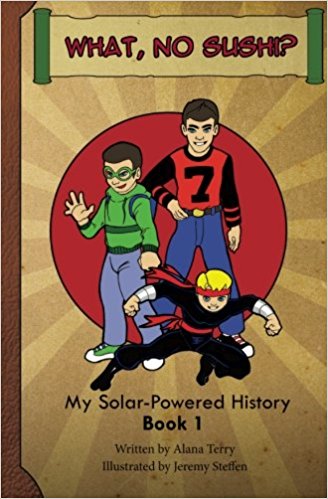What, No Sushi? My Solar-Powered History at a Japanese-American Internment Camp (book)
Creators: Alana Terry
Book aimed at elementary school children about three young brothers from Alaska who take a time machine to experience the mass exclusion and incarceration of Japanese Americans during World War II with their great-grandmother in California.
Told in the first-person voice of Lake Otis, a boy of around ten years old, the story begins in Anchorage, Alaska, where Lake, his brothers Benson (around seven or eight) and O'Malley live with their parents, an inventor father and an archeologist mother. The boys are one-quarter Japanese on their mother's side and are homeschooled by both parents. A history buff, Lake has read about the Japanese American incarceration in a history book and asked his father whether bachan, the boys' great-grandmother in Sacramento, California, had gone to a concentration camp. The question inspires the father to create a solar-powered time machine that deposits the three boys in a strawberry field in Salinas, California, in 1942, where they meet their Kimiko Matsumoto, a girl of about twelve, whom they soon deduce is their bachan. Visible only to Kimiko (and not to the rest of her family), the boys observe her packing up her things and go with her on the train to the Amache , Colorado, concentration camp, where they observe living conditions in the camp, before their father brings them back to the present. The book includes discussion questions, but no bibliography or additional historical information.
Author Alana Terry is a writer of Christian fiction and children's books, including two others in the Solar-Powered History series. Like the unnamed mother in What, No Sushi? , Terry lives in Alaska, is of half-Japanese descent, and homeschools her three boys.
Terry does not include a lot of detail about the roundup, journey, and incarceration, though what is included in generally accurate. However, the actual Japanese American residents of Salinas were sent first to the Salinas Assembly Center , with nearly all going on to the Poston , Arizona, concentration camp, with the rest going to Tule Lake . There is also a scene during the first night at Amache in which the boys see Kenji, Kimiko's oldest brother, argue with a friend and announce that he will volunteer for the army to demonstrate his loyalty. However Japanese Americans were at that point prohibited from military service and not allowed to join the army until the formation of the 442nd Regimental Combat Team in the spring of 1943, some eight or nine months later.
Might also like Fred Korematsu Speaks Up by Laura Atkins and Stan Yogi; The Japanese Internment Camps: A History Perspectives Book by Rachel A. Bailey; Children of the Relocation Camps by Catherine A. Welch
| Author | Alana Terry |
|---|---|
| Illustrator | Jeremy Steffen |
| Pages | 101 |
| Publication Date | 2013 |
For More Information
Author website: http://www.alanaterry.com/ .
